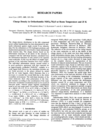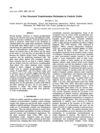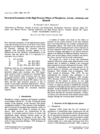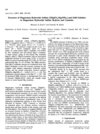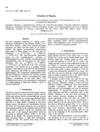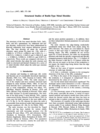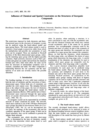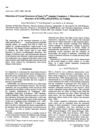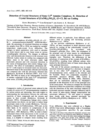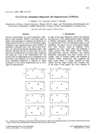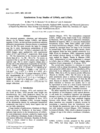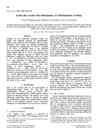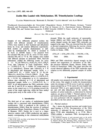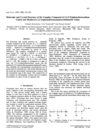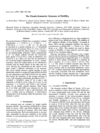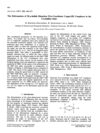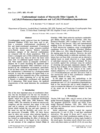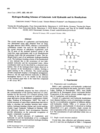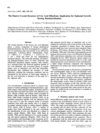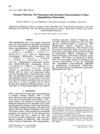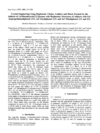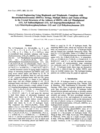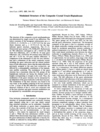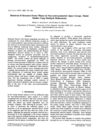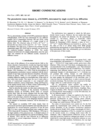issue contents
June 1997 issue

Cover illustration: Contoured distribution of hydrogen bonds from N-H and O-H donors about the oxygen acceptors of the disulfate dianion. Data for the 232 hydrogen bonds (O...H > 2.62 Å) were computed from the Cambridge Structural Database and the required symmetry was applied to generate the final distribution. Courtesy of M. Verdonk and J. Cole
research papers
Download citation


Download citation


The charge density in orthorhombic nickel sulfate heptahydrate has been determined at room temperature and 25 K from single crystal X-ray data. Hydrogen parameters at 25 K were determined by neutron diffraction.
Download citation


Download citation


The crystal structure of synthetic tetrahedrite, Cu12Sb4S13, is refined from single crystal X-ray data in the 295–573 K temperature range, with respect to non-harmonic displacement parameters of the Cu atoms. A suggestion for ion conduction pathways is derived.
During dynamic reduction of vanadyl pyrophosphate (VPO) catalysts used in butane oxidation to maleic anhydride, by in situ electron diffraction and microscopy, recurrent dislocations of atoms are observed by a novel glide shear process. Ordering transforms the orthorhombic VPO into an anion-deficient tetragonal structure. The results have important implications in oxide catalysis and oxide crystallography.
Structural phase transitions in phosphorus, arsenic, antimony and bismuth are reviewed and the transition sequence is expressed in a unified table. It is shown how the network of the densest atomic plane changes on transition.
Download citation


Download citation


The structure of magnesium hydroxide sulfate contains ternary groups of face-shared Mg octahedra, permitting a new understanding of the complex solid solution 2MgSO4.xMg(OH)2.(2-2x)H2O and revising the structure assumed for magnesium hydroxide sulfate hydrate and the ocean-floor sulfate caminite.
Download citation


Download citation


The incommensurately modulated structure of Mn8Sn5 has been solved using standard crystallographic methods, as well as by a modulated structure approach. The advantages of the latter method are demonstrated.
Download citation


Download citation


The structures of four rutile-type metal dioxides, GeO2, SnO2, RuO2 and IrO2, have been redetermined from neutron diffraction powder data. Taking these results, along with those available from previous neutron diffraction studies, the systematic structural trends in rutile-type metal dioxides have been explored.
Possible long-range orderings in a crystal are restricted to those allowed by the space groups that are compatible with the short-range (chemical) order.
The anisotropy of [Co(NH3)5NO2]Cl(NO3) structural distortion on cooling from 290 to 150 K was studied by variable- temperature single-crystal X-ray diffraction. Lattice strain on cooling was compared with that under high hydrostatic pressure and with the distortion induced in the same structure by homogeneous nitro–nitrito linkage isomerization. The role of non-covalent interactions, in particular, of hydrogen bonds, in the anisotropy of structural distortion was considered.
Download citation


Download citation


The anisotropy of [Co(NH3)5NO2]Cl2 and [Co(NH3)5NO2]Br2 structural distortion on cooling from 290 to 150 K was studied by variable-temperature single-crystal X-ray diffraction. Lattice strain on cooling was compared with that under high hydrostatic pressure and with the distortion induced in the same structures by homogeneous nitro–nitrito linkage isomerization. The role of non-covalent interactions, in particular, of hydrogen bonds, in the anisotropy of structural distortion was considered.
The Pb and Zr displacements in the superstructure of PbZrO3 were examined by a method using the effect of anomalous dispersion. Zr participates in the superstructure along z.
Download citation


Download citation


Exchange interactions move electrons from where heavy Nb(Ta) overlap towards more open regions nearer the Li atom. The electron density basis of ferroelectricity in crystalline LiNbO3 and LiTaO3, as inferred from synchrotron radiation measurements, is consistent with the structural and vibrational evidence.
X-ray and neutron diffraction Rietveld analyses of monomethylamine (MMA) loaded zeolites rho revealed the MMA molecule in the α-cage with the N atom pointing to the single eight-ring. Upon dehydration it migrates into the double eight-ring accompanied by a transition from Im-3 to I-43m.
X-ray Rietveld analysis of dimethylamine (DMA) loaded zeolites rho revealed the DMA molecule to reside on the center axis through the α-cage with the N atoms pointing to the single eight-ring and the two methyl groups oriented towards the center of the α-cage.
X-ray and neutron diffraction Rietveld analyses on trimethyl-amine (TMA) loaded zeolites rho showed that the TMA mole-cules reside with the N and H atoms on the central axis pointing towards the center of the single eight-ring, whilst the three methyl groups point away to the center of the α-cage.
Download citation


Download citation


The molecular and crystal structure of the complex composed of 2,3,5-triphenyltetrazolium dichloro-(1,3,5-triphenylforma- zanato)cobaltate(II) is reported. Tetrahedral geometry is realized around the high spin state cobalt(II) ion in the complex.
CCDC reference: 131662
Download citation


Download citation


Pb(SC6H5)2 has equally spaced polymeric layers perpendicular to a* that are partially disordered over alternative origins b/2 apart. The average structure can be either monoclinic or orthorhombic, centrosymmetric or non-centrosymmetric, depending on the disorder parameters.
CCDC reference: 1247000
The linear relationship between the degree of coordination polyhedra deformation (τ) on the SQP ⇌ TBP paths and CuII bond lengths and valence angles has been established by a structural correlation method. Six different paths of deformation between trigonal bipyramid (TBP) and square pyramid (SQP) have been proposed.
Structural data from the Cambridge Structural Database have been used to perform a conformational classification of free and metal-coordinated 15-membered oxa and thia macrocycles.
Download citation


Download citation


The hydrogen-bonding scheme of galactonic acid hydrazide is mainly characterized by an antidromic hydrogen-bonding cycle, whereas the hemihydrate exhibits an intricate pattern. Both structures crystallize in a herringbone arrangement.
Download citation


Download citation


The crystal structure of uric acid dihydrate, a known component of human pathological biomineralizations, fully clarifies on a structural basis the observed epitaxial growth of uric acid dihydrate with associated phases in human stones, such as anhydrous uric acid and whewellite.
CCDC reference: 131661
Download citation


Download citation


The structures of biguanidinium mono-dinitramide, biguani- dinium bis-dinitramide and biguanidinium bis-dinitramide monohydrate are characterized by cations with two planar halves twisted with respect to each other, anions of variable geometry and extensive hydrogen bonding.
Download citation


Download citation


Bisphenols X(C6H4OH)2, where X = Me2C, O or S, form hydrogen-bonded adducts with the cage diamine N(CH2CH2)3N having chain, ladder and sheet topologies.
Download citation


Download citation


The cage tetra-annular HMTA (CH2)6N4 forms hydrogen- bonded adducts giving chain or double-helix topologies with bisphenols and triple-helix or chain-of-rings topology with trisphenols.
Download citation


Download citation


The trisphenol CH3C(C6H4OH)3 and its adducts with both DABCO and piperazine form three-dimensional hydrogen- bonded networks are interwoven.
The structure of the inclusion compound urea/n-heptadecane was refined as a composite crystal. A nonnegligible contribution of the guest structure satellite scattering to main host reflections and an adaptation of the guest structure to the host structure was found.
Structure factors with known magnitude and phase are con- structed for several molecular crystals in non-centrosymmetric space groups and used to calibrate the retrieval of structure-factor phase information with a variety of scattering factor models. For several systems (urea, hydrogen peroxide, L-alanine and bora- zine) the results confirm that multipole refinements against experimental data yield highly accurate phases and hence reliable distributions; for the exceptional case of HMT a simple eigenvalue filtering provides phases of comparable accuracy.
short communications
X-ray diffraction of a single crystal in an external electric field was used to determine the piezoelectric tensor element d33 of KTP.
Correction to Acta Cryst. (1997). B53, 231-240.


 journal menu
journal menu











